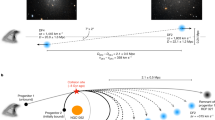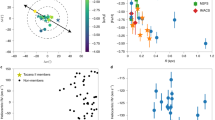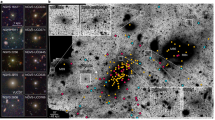Abstract
Ultra-diffuse galaxies (UDGs) are the lowest-surface-brightness galaxies known, with typical stellar masses of dwarf galaxies but sizes similar to those of larger galaxies such as the Milky Way1. The reason for their extended sizes is debated, with suggested internal processes such as angular momentum2, feedback3,4 or mergers5 versus external mechanisms6,7,8,9 or a combination of both10. Observationally, we know that UDGs are red and quiescent in groups and clusters11,12 whereas their counterparts in the field are blue and star-forming13,14,15,16. This dichotomy suggests environmental effects as the main culprits. However, this scenario is challenged by recent observations of isolated quiescent UDGs in the field17,18,19. Here we use the ΛCDM (or Λ cold dark matter, where Λ is the cosmological constant) cosmological hydrodynamical simulation to show that isolated quenched UDGs are formed as backsplash galaxies that were once satellites of another galactic, group or cluster halo but are today a few Mpc away from them. These interactions, albeit brief, remove the gas and tidally strip the outskirts of the dark matter haloes of the now quenched and seemingly isolated UDGs, which are born as star-forming field UDGs occupying dwarf-mass dark matter haloes. Quiescent UDGs may therefore be found in non-negligible numbers in filaments and voids, bearing the mark of past interactions as stripped outer haloes devoid of dark matter and gas compared to dwarfs with similar stellar content.
This is a preview of subscription content, access via your institution
Access options
Access Nature and 54 other Nature Portfolio journals
Get Nature+, our best-value online-access subscription
$29.99 / 30 days
cancel any time
Subscribe to this journal
Receive 12 digital issues and online access to articles
$119.00 per year
only $9.92 per issue
Buy this article
- Purchase on Springer Link
- Instant access to full article PDF
Prices may be subject to local taxes which are calculated during checkout




Similar content being viewed by others
Data availability
This letter is based on snapshots, subhalo catalogues and merger trees from the cosmological hydrodynamical TNG50 simulation25,26 of the IllustrisTNG project37,38,39,40,41,42,43. These data are publicly available at https://www.tng-project.org/. ASCII tables with the simulation data for our sample of UDGs in Figs. 1, 2 and 4 are available in the public repository https://github.com/josegit88/public_data_files/tree/main/ascii_files_isolated_UDGs_TNG50. Source data are provided with this paper.
Code Availability
Scripts used for reading of and access to the snapshot, merger trees and subhalo data are publically available at the TNG database. Visualizations were made using the publicly available Py-SPHViewer code61. Any correspondence and/or request for materials pertaining to this manuscript should be directed to J.A.B.
References
van Dokkum, P. G. et al. Forty-seven Milky Way-sized, extremely diffuse galaxies in the Coma cluster. Astrophys. J. Lett. 798, L45 (2015).
Amorisco, N. C. & Loeb, A. Ultradiffuse galaxies: the high-spin tail of the abundant dwarf galaxy population. Mon. Not. R. Astron. Soc. 459, L51–L55 (2016).
Di Cintio, A. et al. NIHAO – XI. Formation of ultra-diffuse galaxies by outflows. Mon. Not. R. Astron. Soc. 466, L1–L6 (2017).
Chan, T. K. et al. The origin of ultra diffuse galaxies: stellar feedback and quenching. Mon. Not. R. Astron. Soc. 478, 906–925 (2018).
Wright, A. C. et al. The formation of isolated ultradiffuse galaxies in ROMULUS25. Mon. Not. R. Astron. Soc. 502, 5370–5389 (2021).
Safarzadeh, M. & Scannapieco, E. The fate of gas-rich satellites in clusters. Astrophys. J. 850, 99 (2017).
Carleton, T. et al. The formation of ultra-diffuse galaxies in cored dark matter haloes through tidal stripping and heating. Mon. Not. R. Astron. Soc. 485, 382–395 (2019).
Jiang, F. et al. Formation of ultra-diffuse galaxies in the field and in galaxy groups. Mon. Not. R. Astron. Soc. 487, 5272–5290 (2019).
Tremmel, M. et al. The formation of ultradiffuse galaxies in the RomulusC galaxy cluster simulation. Mon. Not. R. Astron. Soc. 497, 2786–2810 (2020).
Sales, L. V. et al. The formation of ultradiffuse galaxies in clusters. Mon. Not. R. Astron. Soc. 494, 1848–1858 (2020).
Koda, J., Yagi, M., Yamanoi, H. & Komiyama, Y. Approximately a thousand ultra-diffuse galaxies in the Coma cluster. Astrophys. J. Lett. 807, L2 (2015).
Yagi, M., Koda, J., Komiyama, Y. & Yamanoi, H. Catalog of ultra-diffuse galaxies in the Coma clusters from Subaru imaging data. Astrophys. J. Suppl. Ser. 225, 11 (2016).
Greco, J. P. et al. A study of two diffuse dwarf galaxies in the field. Astrophys. J. 866, 112 (2018).
Rong, Y. et al. Lessons on star-forming ultra-diffuse galaxies from the stacked spectra of the Sloan Digital Sky Survey. Astrophys. J. Lett. 899, L12 (2020).
Barbosa, C. E. et al. One Hundred SMUDGes in S-PLUS: ultra-diffuse galaxies glourish in the field. Astrophys. J. Suppl. Ser. 247, 46 (2020).
Tanoglidis, D. et al. Shadows in the dark: low-surface-brightness galaxies discovered in the Dark Energy Survey. Astrophys. J. Suppl. Ser. 252, 18 (2021).
Martínez-Delgado, D. et al. Discovery of an ultra-diffuse galaxy in the Pisces-Perseus supercluster. Astron. J. 151, 96 (2016).
Román, J., Beasley, M. A., Ruiz-Lara, T. & Valls-Gabaud, D. Discovery of a red ultra-diffuse galaxy in a nearby void based on its globular cluster luminosity function. Mon. Not. R. Astron. Soc. 486, 823–835 (2019).
Prole, D. J., van der Burg, R. F. J., Hilker, M. & Spitler, L. R. The quiescent fraction of isolated low surface brightness galaxies: observational constraints. Mon. Not. R. Astron. Soc. 500, 2049–2062 (2021).
van Dokkum, P. et al. A galaxy lacking dark matter. Nature 555, 629–632 (2018).
Lim, S. et al. The globular cluster systems of ultra-diffuse galaxies in the Coma cluster. Astrophys. J. 862, 82 (2018).
Doppel, J. E. et al. Globular clusters as tracers of the dark matter content of dwarfs in galaxy clusters. Mon. Not. R. Astron. Soc. 502, 1661–1677 (2021).
Mancera Piña, P. E. et al. The evolution of ultra-diffuse galaxies in nearby galaxy clusters from the Kapteyn IAC WEAVE INT Clusters Survey. Mon. Not. R. Astron. Soc. 485, 1036–1052 (2019).
Ferré-Mateu, A. et al. Origins of ultradiffuse galaxies in the Coma cluster – II. Constraints from their stellar populations. Mon. Not. R. Astron. Soc. 479, 4891–4906 (2018).
Pillepich, A. et al. First results from the TNG50 simulation: the evolution of stellar and gaseous discs across cosmic time. Mon. Not. R. Astron. Soc. 490, 3196–3233 (2019).
Nelson, D. et al. First results from the TNG50 simulation: galactic outflows driven by supernovae and black hole feedback. Mon. Not. R. Astron. Soc. 490, 3234–3261 (2019).
Martín-Navarro, I. et al. Extreme chemical abundance ratio suggesting an exotic origin for an ultradiffuse galaxy. Mon. Not. R. Astron. Soc. 484, 3425–3433 (2019).
Lim, S. et al. The Next Generation Virgo Cluster Survey (NGVS). XXX. Ultra-diffuse galaxies and their globular cluster systems. Astrophys. J. 899, 69 (2020).
Balogh, M. L., Navarro, J. F. & Morris, S. L. The origin of star formation gradients in rich galaxy clusters. Astrophys. J. 540, 113–121 (2000).
Sales, L. V., Navarro, J. F., Abadi, M. G. & Steinmetz, M. Cosmic ménage à trois: the origin of satellite galaxies on extreme orbits. Mon. Not. R. Astron. Soc. 379, 1475–1483 (2007).
Cardona-Barrero, S. et al. NIHAO XXIV: rotation- or pressure-supported systems? Simulated ultra diffuse galaxies show a broad distribution in their stellar kinematics. Mon. Not. R. Astron. Soc. 497, 4282–4292 (2020).
Joshi, G. D. et al. The fate of disc galaxies in IllustrisTNG clusters. Mon. Not. R. Astron. Soc. 496, 2673–2703 (2020).
Moster, B. P., Naab, T. & White, S. D. M. Galactic star formation and accretion histories from matching galaxies to dark matter haloes. Mon. Not. R. Astron. Soc. 428, 3121–3138 (2013).
Gunn, J. E. & Gott, J. R.III On the infall of matter into clusters of galaxies and some effects on their evolution. Astrophys. J. 176, 1–19 (1972).
Abadi, M. G., Moore, B. & Bower, R. G. Ram pressure stripping of spiral galaxies in clusters. Mon. Not. R. Astron. Soc. 308, 947–954 (1999).
Tumlinson, J., Peeples, M. S. & Werk, J. K. The circumgalactic medium. Annu. Rev. Astron. Astrophys. 55, 389–432 (2017).
Pillepich, A. et al. Simulating galaxy formation with the IllustrisTNG model. Mon. Not. R. Astron. Soc. 473, 4077–4106 (2018).
Pillepich, A. et al. First results from the IllustrisTNG simulations: the stellar mass content of groups and clusters of galaxies. Mon. Not. R. Astron. Soc. 475, 648–675 (2018).
Springel, V. et al. First results from the IllustrisTNG simulations: matter and galaxy clustering. Mon. Not. R. Astron. Soc. 475, 676–698 (2018).
Nelson, D. et al. First results from the IllustrisTNG simulations: the galaxy colour bimodality. Mon. Not. R. Astron. Soc. 475, 624–647 (2018).
Naiman, J. P. et al. First results from the IllustrisTNG simulations: a tale of two elements – chemical evolution of magnesium and europium. Mon. Not. R. Astron. Soc. 477, 1206–1224 (2018).
Marinacci, F. et al. First results from the IllustrisTNG simulations: radio haloes and magnetic fields. Mon. Not. R. Astron. Soc. 480, 5113–5139 (2018).
Nelson, D. et al. The IllustrisTNG simulations: public data release. Comput. Astrophys. Cosmol. 6, 2 (2019).
Weinberger, R. et al. Simulating galaxy formation with black hole driven thermal and kinetic feedback. Mon. Not. R. Astron. Soc. 465, 3291–3308 (2017).
Vogelsberger, M. et al. Introducing the Illustris Project: simulating the coevolution of dark and visible matter in the Universe. Mon. Not. R. Astron. Soc. 444, 1518–1547 (2014).
Vogelsberger, M. et al. Properties of galaxies reproduced by a hydrodynamic simulation. Nature 509, 177–182 (2014).
Genel, S. et al. Introducing the Illustris project: the evolution of galaxy populations across cosmic time. Mon. Not. R. Astron. Soc. 445, 175–200 (2014).
Springel, V. E pur si muove: Galilean-invariant cosmological hydrodynamical simulations on a moving mesh. Mon. Not. R. Astron. Soc. 401, 791–851 (2010).
Weinberger, R., Springel, V. & Pakmor, R. The AREPO public code release. Astrophys. J. Suppl. Ser. 248, 32 (2020).
Springel, V. N-GenIC: cosmological structure initial conditions Astrophysics Source Code Library ascl: 1502.003 (2015).
Alves, J., Combes, F., Ferrara, A., Forveille, T. & Shore, S. Planck 2015 results. Astron. Astrophys. 594, E1 (2016).
Davis, M., Efstathiou, G., Frenk, C. S. & White, S. D. M. The evolution of large-scale structure in a universe dominated by cold dark matter. Astrophys. J. 292, 371–394 (1985).
Springel, V., White, S. D. M., Tormen, G. & Kauffmann, G. Populating a cluster of galaxies – I. Results at z = 0. Mon. Not. R. Astron. Soc. 328, 726–750 (2001).
Nelson, D. et al. The Illustris simulation: public data release. Astron. Comput. 13, 12–37 (2015).
Sales, L. V. et al. The origin of discs and spheroids in simulated galaxies. Mon. Not. R. Astron. Soc. 423, 1544–1555 (2012).
Snyder, G. F. et al. Galaxy morphology and star formation in the Illustris Simulation at z = 0. Mon. Not. R. Astron. Soc. 454, 1886–1908 (2015).
Rodriguez-Gomez, V. et al. The merger rate of galaxies in the Illustris simulation: a comparison with observations and semi-empirical models. Mon. Not. R. Astron. Soc. 449, 49–64 (2015).
DeFelippis, D.et al. A Comparison of circumgalactic MgII absorption between the TNG50 simulation and the MEGAFLOW survey. Preprint at https://arxiv.org/abs/2102.08383 (2021).
Fuse, C., Marcum, P. & Fanelli, M. Extremely isolated early-type galaxies in the Sloan Digital Sky Survey. I. The sample. Astron. J. 144, 57 (2012).
Genel, S. et al. The size evolution of star-forming and quenched galaxies in the IllustrisTNG simulation. Mon. Not. R. Astron. Soc. 474, 3976–3996 (2018).
Benitez-Llambay, A. py-sphviewer: Py-SPHViewer v1.0.0 https://zenodo.org/record/21703#.YQK-zehKhaQ (2015).
Acknowledgements
J.A.B. and M.G.A. acknowledge financial support from CONICET through PIP grant 11220170100527CO. L.V.S. is grateful for support from NSF grant CAREER-1945310 and NASA grant ATP-80NSSC20K0566. A.P. acknowledges support from the Deutsche Forschungsgemeinschaft (DFG, German Research Foundation) through project 138713538 - SFB 881 (‘The Milky Way System’, subproject C09). D.N. acknowledges funding from the DFG through an Emmy Noether Research Group grant (NE 2441/1-1). F.M. acknowledges support through the programme ‘Rita Levi Montalcini’ of the Italian MUR. M.C. is partially supported by NSF grants AST-1518257 and AST-1815475. P.T. acknowledges support from NSF grants AST-1909933 and AST-200849 and from NASA ATP grant 80NSSC20K0502. M.V. acknowledges support from NASA ATP grants 16-ATP16-0167, 19-ATP19-0019, 19-ATP19-0020 and 19-ATP19-0167 and from NSF grants AST-1814053, AST-1814259, AST-1909831 and AST-2007355.
Author information
Authors and Affiliations
Contributions
The listed authors made substantial contributions to this manuscript; all co-authors read and commented on the document. J.A.B. led the analysis of the simulation, compiled observational data from the literature and made all figures. L.V.S. and M.G.A. are responsible for the original idea and mentorship of J.A.B. throughout the project. L.V.S. led the writing of the manuscript and the response to the referee report with substantial contributions from J.A.B., M.G.A., A.P., D.N., F.M. and L.H. Co-author M.C. provided the expertise on the observational consequences of the results and on the study of quenching of dwarf galaxies. A.P., D.N., F.M., R.P., P.T., M.V. and L.H. are core members of the TNG50 simulation who set up, developed and ran the simulation that this manuscript is based on.
Corresponding author
Ethics declarations
Competing interests
The authors declare no competing interests.
Additional information
Peer review information Nature Astronomy thanks Arianna Di Cintio and the other, anonymous, reviewer(s) for their contribution to the peer review of this work.
Publisher’s note Springer Nature remains neutral with regard to jurisdictional claims in published maps and institutional affiliations.
Supplementary information
Supplementary Information
Supplementary Figs. 1–6 and discussion.
Source data
Source Data Fig. 1
ASCII files with data per column: stellar masses (M⊙) and three-dimensional half-mass radius (kpc).
Source Data Fig. 2
ASCII files with data per column: stellar masses (M⊙), colour (g−r) and star formation rate (M⊙ yr−1).
Source Data Fig. 4
ASCII files with data per column: stellar masses (M⊙), stellar ages (Gyr), κrot and virial masses (M⊙).
Rights and permissions
About this article
Cite this article
Benavides, J.A., Sales, L.V., Abadi, M.G. et al. Quiescent ultra-diffuse galaxies in the field originating from backsplash orbits. Nat Astron 5, 1255–1260 (2021). https://doi.org/10.1038/s41550-021-01458-1
Received:
Accepted:
Published:
Issue Date:
DOI: https://doi.org/10.1038/s41550-021-01458-1
This article is cited by
-
Ultra-diffuse galaxies on the run
Nature Astronomy (2021)



